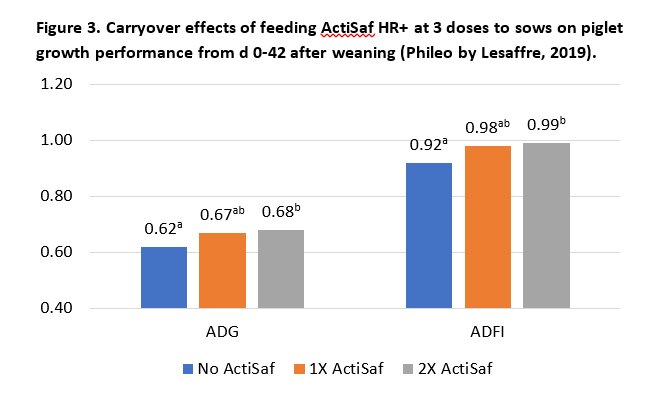

Joe Loughmiller, PhD (j.loughmiller@phileo.lesaffre.com)
Phileo by Lesaffre
Feeding premium active dry yeast probiotics (Procreatin 7® or ActiSaf HR+®) to pigs has previously demonstrated performance and health improvements. Genetics, management, and nutrition improvements have raised questions about the continued need for premium yeast probiotics Procreatin 7 or ActiSaf HR+. While research has demonstrated the benefits of premium yeast probiotics and yeast extracts on sow and litter performance, current research measuring the post-weaning carryover growth performance effects on weaned pigs from sows fed premium yeast probiotics Procreatin 7 or ActiSaf HR+ in gestation and lactation is needed.
Figure 1 represents data from Phileo with a prior Phileo premium yeast product, BioSaf. These results demonstrate that piglets from sows fed a premium yeast probiotic like BioSaf or ActiSaf HR+ have live, recoverable BioSaf in their feces, suggesting that they ingested the product through eating the sow’s feed or coprophagy while living around the sow. Further research indicates that feeding ActiSaf HR+ premium yeast probiotic increased gut microbiota variation in the pig’s gut while reducing microbiota variation between pigs in the same group (Figure 2; Kiros et al., 2018). These results further suggest that the carryover benefit in pigs after weaning could be valuable. Therefore, the objective of this experiment was to measure growth performance of pigs from sows fed the premium yeast probiotic ActiSaf HR+ in gestation and lactation during the initial 42 days after weaning.

In this trial, we used1,260 pigs (PIC 1050 X 359; initially 19 d of age, ~12.2 lbs) were sourced with negative PRRS, PEDv and M. hyopneumonea status. Each pen at weaning was mixed sex with 21 pigs/pen with 10 pens per treatment. At weaning, all pigs received PCV2 and Mycoplasma vaccination. Pens of pigs were weighed at d 0, 12, 23, and 42. Periodic feed inventory was also collected to calculate the average daily feed disappearance and feed efficiency.


Treatments were arranged in a 3×2 design. The 3 sow treatments and 2 nursery feed treatments with pen as the experimental unit made up the 6 treatments. Growth performance, morbidity and mortality were all analyzed by treatment. During this trial, no main effect or interactions were observed for the nursery feed treatments. Thus, only the sow treatment carryover effects on weaned pig performance are shown.
On d 25, 3 dead pigs were submitted to the ISU VDL. Results indicated the pigs were positive for PRRSv, Rotavirus, PCV 2&3, and F18 hemolytic e. coli. This occurred about d 23-25 after weaning, with the other diseases likely secondary to the PRRSv infection. Consequently, 147 were removed (11.6%).
Pigs from sows fed ActiSaf HR+ had heavier d 12 d 23, and d 42 bodyweight (Table 1). The growth performance improvements for pigs from sows fed ActiSaf HR+ were primarily from increased post-weaning feed intake (Figure 3). Further, cost/lb gained and mortality tended to be lower for pigs from sows fed ActiSaf HR+. These results, when combined with those in Figures 1 & 2 demonstrate that feeding gestating and lactating sows a premium yeast probiotic like Procreatin 7 or ActiSaf HR+ provides valuable carryover benefits on their weaned piglets health, growth performance and cost of production.




Full trial results can be obtained by emailed request to the author.




